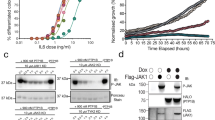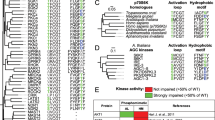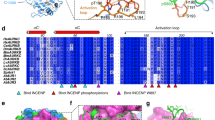Abstract
The protein kinase Akt/PKB is stimulated by the phosphorylation of two regulatory residues, Thr 309 of the activation segment and Ser 474 of the hydrophobic motif (HM), that are structurally and functionally conserved within the AGC kinase family. To understand the mechanism of PKB regulation, we determined the crystal structures of activated kinase domains of PKB in complex with a GSK3β-peptide substrate and an ATP analog. The activated state of the kinase was generated by phosphorylating Thr 309 using PDK1 and mimicking Ser 474 phosphorylation either with the S474D substitution or by replacing the HM of PKB with that of PIFtide, a potent mimic of a phosphorylated HM. Comparison with the inactive PKB structure indicates that the role of Ser 474 phosphorylation is to promote the engagement of the HM with the N-lobe of the kinase domain, promoting a disorder-to-order transition of the αC helix. The αC helix, by interacting with pThr 309, restructures and orders the activation segment, generating an active kinase conformation. Analysis of the interactions between PKB and the GSK3β-peptide explains how PKB selects for protein substrates distinct from those of PKA.
This is a preview of subscription content, access via your institution
Access options
Subscribe to this journal
Receive 12 print issues and online access
$189.00 per year
only $15.75 per issue
Buy this article
- Purchase on Springer Link
- Instant access to full article PDF
Prices may be subject to local taxes which are calculated during checkout




Similar content being viewed by others
References
Brazil, D.P. & Hemmings, B.A. Trends Biochem. Sci. 26, 657–664 (2001).
Alessi, D.R. et al. EMBO J. 15, 6541–6551 (1996).
Alessi, D.R. et al. Curr. Biol. 7, 261–269 (1997).
Stokoe, D. et al. Science 277, 567–570 (1997).
Testa, R. & Bellacosa, A. Proc. Natl. Acad. Sci. USA 98, 10983–10985 (2001).
Parekh, D.B., Ziegler, W. & Parker, P.J. EMBO J. 19, 496–503 (2000).
Lang, F. & Cohen, P. Sci. STKE 108, RE17 (2001).
Yang, J. et al. Mol. Cell 9, 1227–1240 (2002).
Balendran, A. et al. Curr. Biol. 9, 393–404 (1999).
Cross, D.A., Alessi, D.R., Cohen, P., Andjelkovich, M. & Hemmings, B.A. Nature 378, 785–789 (1995).
Knighton, D.R. et al. Science 253, 407–414 (1991).
Knighton, D.R. et al. Science 253, 414–420 (1991).
Bossemeyer, D., Engh, R.A., Kinzel, V., Ponstingl, H. & Huber, R. EMBO J. 12, 849–859 (1993).
Johnson, L.N., Noble, M.E. & Owen, D.J. Cell 85, 149–158 (1996).
Etchebehere, L.C. et al. Eur. J. Biochem. 248, 820–826 (1997).
Alessi, D.R., Caudwell, F.B., Andjelkovic, M., Hemmings, B.A. & Cohen, P. FEBS Lett. 399, 333–338 (1996).
Obata, T. et al. J. Biol. Chem. 275, 36108–36115 (2000).
Kennelly, P.J. & Krebs, E.G. J. Biol. Chem. 266, 15555–15558 (1991).
Lowe, E.D. et al. EMBO J. 16, 6646–6658 (1997).
Biondi, R.M. et al. EMBO J. 21, 4219–4228 (2002).
Biondi, R.M. et al. EMBO J. 19, 979–988 (2000).
Collaborative Computational Project, Number 4. Acta Crystallogr. D 50, 760–763 (1994).
Brünger, A.T. et al. Acta Crystallogr. D 54, 905–921 (1998).
Jones, T.A., Zou, J.Y., Cowan, S.W. & Kjeldgaard, M. Acta Crystallogr. A 50, 157–160 (1991).
Nicholls, A., Sharp, K.A. & Honig, B. Proteins 11, 281–296 (1991).
Acknowledgements
We thank the staff at the ESRF, Grenoble, France, for access to synchrotron radiation facilities, and T. Dale (ICR) for the GSK3β peptide. The work was supported by grants from Cancer Research UK and from the ICR to D.B. Friedrich Miescher-Institut is part of the Novartis Research Foundation.
Author information
Authors and Affiliations
Corresponding author
Ethics declarations
Competing interests
The authors declare no competing financial interests.
Rights and permissions
About this article
Cite this article
Yang, J., Cron, P., Good, V. et al. Crystal structure of an activated Akt/Protein Kinase B ternary complex with GSK3-peptide and AMP-PNP. Nat Struct Mol Biol 9, 940–944 (2002). https://doi.org/10.1038/nsb870
Received:
Accepted:
Published:
Issue Date:
DOI: https://doi.org/10.1038/nsb870
This article is cited by
-
FKBP51 plays an essential role in Akt ubiquitination that requires Hsp90 and PHLPP
Cell Death & Disease (2023)
-
Stereochemical engineering yields a multifunctional peptide macrocycle inhibitor of Akt2 by fine-tuning macrocycle-cell membrane interactions
Communications Chemistry (2023)
-
Tanshinone IIA promotes apoptosis by downregulating BCL2 and upregulating TP53 in triple-negative breast cancer
Naunyn-Schmiedeberg's Archives of Pharmacology (2023)
-
Histone acetyltransferase NAA40 modulates acetyl-CoA levels and lipid synthesis
BMC Biology (2022)
-
Structures of rhodopsin in complex with G-protein-coupled receptor kinase 1
Nature (2021)



